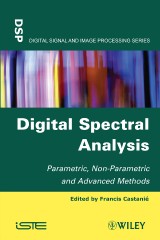Details

Digital Spectral Analysis
Parametric, Non-Parametric and Advanced Methods1. Aufl.
|
144,99 € |
|
| Verlag: | Wiley |
| Format: | EPUB |
| Veröffentl.: | 04.02.2013 |
| ISBN/EAN: | 9781118601839 |
| Sprache: | englisch |
| Anzahl Seiten: | 400 |
DRM-geschütztes eBook, Sie benötigen z.B. Adobe Digital Editions und eine Adobe ID zum Lesen.
Beschreibungen
<i>Digital Spectral Analysis</i> provides a single source that offers complete coverage of the spectral analysis domain. This self-contained work includes details on advanced topics that are usually presented in scattered sources throughout the literature.<br /> The theoretical principles necessary for the understanding of spectral analysis are discussed in the first four chapters: fundamentals, digital signal processing, estimation in spectral analysis, and time-series models.<br /> An entire chapter is devoted to the non-parametric methods most widely used in industry.<br /> High resolution methods are detailed in a further four chapters: spectral analysis by stationary time series modeling, minimum variance, and subspace-based estimators.<br /> Finally, advanced concepts are the core of the last four chapters: spectral analysis of non-stationary random signals, space time adaptive processing: irregularly sampled data processing, particle filtering and tracking of varying sinusoids.<br /> Suitable for students, engineers working in industry, and academics at any level, this book provides a rare complete overview of the spectral analysis domain.<br />
<p>Preface xiii</p> <p><b>PART 1. TOOLS AND SPECTRAL ANALYSIS 1</b></p> <p><b>Chapter 1. Fundamentals 3</b><br /> Francis CASTANIÉ</p> <p>1.1. Classes of signals 3</p> <p>1.2. Representations of signals 9</p> <p>1.3. Spectral analysis: position of the problem 20</p> <p>1.4. Bibliography 21</p> <p><b>Chapter 2. Digital Signal Processing 23</b><br /> Éric LE CARPENTIER</p> <p>2.1. Introduction 23</p> <p>2.2. Transform properties 24</p> <p>2.3. Windows 49</p> <p>2.4. Examples of application 57</p> <p>2.5. Bibliography 64</p> <p><b>Chapter 3. Introduction to Estimation Theory with Application in Spectral Analysis 67</b><br /> Olivier BESSON and André FERRARI</p> <p>3.1. Introduction 67</p> <p>3.2. Covariance-based estimation 86</p> <p>3.3. Performance assessment of some spectral estimators 95</p> <p>3.4. Bibliography 102</p> <p><b>Chapter 4. Time-Series Models 105</b><br /> Francis CASTANIÉ</p> <p>4.1. Introduction 105</p> <p>4.2. Linear models 107</p> <p>4.3. Exponential models 117</p> <p>4.4. Nonlinear models 120</p> <p>4.5. Bibliography 121</p> <p><b>PART 2. NON-PARAMETRIC METHODS 123</b></p> <p><b>Chapter 5. Non-Parametric Methods 125</b><br /> Éric LE CARPENTIER</p> <p>5.1. Introduction 125</p> <p>5.2. Estimation of the power spectral density 130</p> <p>5.3. Generalization to higher-order spectra 141</p> <p>5.4. Bibliography 142</p> <p><b>PART 3. PARAMETRIC METHODS 143</b></p> <p><b>Chapter 6. Spectral Analysis by Parametric Modeling145</b><br /> Corinne MAILHES and Francis CASTANIÉ</p> <p>6.1. Which kind of parametric models? 145</p> <p>6.2. AR modeling 146</p> <p>6.3. ARMA modeling 154</p> <p>6.4. Prony modeling 156</p> <p>6.5. Order selection criteria 158</p> <p>6.6. Examples of spectral analysis using parametric modeling 162</p> <p>6.7. Bibliography 166</p> <p><b>Chapter 7. Minimum Variance 169</b><br /> Nadine MARTIN</p> <p>7.1. Principle of the MV method . . 174</p> <p>7.2. Properties of the MV estimator 177</p> <p>7.3. Link with the Fourier estimators 188</p> <p>7.4. Link with a maximum likelihood estimator 190</p> <p>7.5. Lagunas methods: normalized MV and generalized MV 192</p> <p>7.6. A new estimator: the CAPNORM estimator 200</p> <p>7.7. Bibliography 204</p> <p><b>Chapter 8. Subspace-Based Estimators and Application to Partially Known Signal Subspaces 207</b><br /> Sylvie MARCOS and Rémy BOYER</p> <p>8.1. Model, concept of subspace, definition of high resolution 207</p> <p>8.2. MUSIC 211</p> <p>8.3. Determination criteria of the number of complex sine waves 216</p> <p>8.4. The MinNorm method 217</p> <p>8.5. “Linear” subspace methods 219</p> <p>8.6. The ESPRIT method 223</p> <p>8.7. Illustration of the subspace-based methods performance 226</p> <p>8.8. Adaptive research of subspaces 229</p> <p>8.9. Integrating a priori known frequencies into the MUSIC criterion. 233</p> <p>8.10. Bibliography 243</p> <p><b>PART 4. ADVANCED CONCEPTS 251</b></p> <p><b>Chapter 9. Multidimensional Harmonic Retrieval: Exact, Asymptotic, and Modified Cramér-Rao Bounds 253</b><br /> Rémy BOYER</p> <p>9.1. Introduction 253</p> <p>9.2. CanDecomp/Parafac decomposition of the multidimensional<br /> harmonic model 255</p> <p>9.3. CRB for the multidimensional harmonic model 257</p> <p>9.4. Modified CRB for the multidimensional harmonic model 266</p> <p>9.5. Conclusion 272</p> <p>9.6. Appendices 273</p> <p>9.7. Bibliography 284</p> <p><b>Chapter 10. Introduction to Spectral Analysis of Non-Stationary Random Signals 287</b><br /> Corinne MAILHES and Francis CASTANIÉ</p> <p>10.1. Evolutive spectra 288</p> <p>10.2. Non-parametric spectral estimation 290</p> <p>10.3. Parametric spectral estimation 291</p> <p>10.4. Bibliography 297</p> <p><b>Chapter 11. Spectral Analysis of Non-uniformly Sampled Signals 301</b><br /> Arnaud RIVOIRA and Gilles FLEURY</p> <p>11.1. Applicative context 301</p> <p>11.2. Theoretical framework 302</p> <p>11.3. Generation of a randomly sampled stochastic process 302</p> <p>11.4. Spectral analysis using undated samples 305</p> <p>11.5. Spectral analysis using dated samples 309</p> <p>11.6. Perspectives 314</p> <p>11.7. Bibliography 315</p> <p><b>Chapter 12. Space–Time Adaptive Processing 317</b><br /> Laurent SAVY and François LE CHEVALIER</p> <p>12.1. STAP, spectral analysis, and radar signal processing 319</p> <p>12.2. Space–time processing as a spectral estimation problem 327</p> <p>12.3. STAP architectures 334</p> <p>12.4. Relative advantages of pre-Doppler and post-Doppler STAP 354</p> <p>12.5. Conclusion 358</p> <p>12.6. Bibliography 359</p> <p>12.7. Glossary 360</p> <p><b>Chapter 13. Particle Filtering and Tracking of Varying Sinusoids 361</b><br /> David BONACCI</p> <p>13.1. Particle filtering 361</p> <p>13.2. Application to spectral analysis 370</p> <p>13.3. Bibliography 375</p> <p>List of Authors 377</p> <p>Index 379</p>
<p><strong>Francis Castanié</strong> is an emeritus professor of INPT and Laboratory Director of TeSA in Toulouse, France.


















